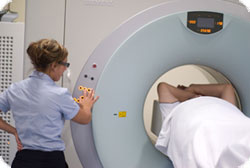The cancer treatment process begins at diagnosis.
Radiation Therapy: uses high energy x-rays to destroy cancer cells. It is often used in conjunction with surgery to shrink tumours before the operation and to mitigate re-growth of cancerous cells post-operation. Radiation therapy can be given externally and internally. Although radiation therapy is a local treatment, it can still damage normal cells causing a range of side effects such as fatigue, swelling and alopecia. These short-term side effects go away after treatment but external-beam radiation can also cause serious long-term side effects such as infertility, neurologic and thyroid problems, and should be discussed thoroughly with a physician.
Hormone Therapy: fights cancer by changing the amount of hormones in the body to treat certain forms of cancer that rely on these chemicals to grow and spread. Hormone therapy is used for cancer of the prostate, breast and reproductive system, and the side-effects vary between men and women, and depending on the drug.
Immunotherapy: (or biologic therapy) stimulates the disease fighting mechanisms within the patient's body to fight cancer. Research is currently underway into developing and improving immunotherapies such as monoclonal antibodies, which are laboratory-produced substances that block specific protein functions by binding to cancer cells, and cancer vaccines, which train the immune system to recognise and attack cancer cells. The side effects are generally flu-like symptoms.
Targeted Treatments: are drugs that target proteins that contribute to cancer, which in turn target cancer cells specifically, as opposed to systemic drug treatments like chemotherapy. Targeted treatments often have different side effects than chemotherapy which are also generally less severe. Many targeted treatments are still in development.
Adapted from the American Society for Clinical Oncology' s online resource centre Cancer.Net. Please visit Cancer.Net for the full text of this article and other useful patient and carer resources.
*The medical terms and definitions provided here are not intended to replace medical information provided by licensed medical professionals. Please contact your doctor if you require medical assistance.
Treatment Plans: will depend on the physician's expert opinion based on the diagnosed tumor or metastasis (Tumor Types). There is no one-size-fits-all treatment for cancer. Treatment options include chemotherapy, surgery, radiation therapy and more, and in some cases a patient will require a combination to maximize the effectiveness of treatment. It is becoming increasingly common to engage a team of experts to provide the best treatment mix for certain patients; please see Multidisciplinary Care for more information. Each treatment has both benefits and side effects, and a patient's physician should discuss both in depth before proceeding. No matter the diagnosis and recommended treatment plan, it is always appropriate to seek a second opinion.
Chemotherapy: (colloquially known as chemo) is a treatment that uses drugs to destroy cancer cells. Medical oncologists specialize in cancer treatment using drugs such as chemotherapy agents. The drugs can interfere with the growth of tumors, shrink or even eliminate the cancer cells. Chemotherapy is often an effective treatment however it can cause side effects because the drugs also affect healthy cells. Side effects often include nausea, vomiting and fatigue but can vary greatly in form and severity depending on the specific drug, cancer type and the individual's reaction. Many of the new chemotherapy drugs now available do not cause the same severity of side effects as the older drugs. Although the side effects are often unpleasant they are not related to the effectiveness of the treatment and generally go away after treatments are finished. Chemotherapy is usually prescribed in a specific number of cycles given over a period of time.
Surgery: involves the removal of cancerous tissue from the body. For some cancers, surgery is the primary treatment and can even provide a cure but it can also be used as a diagnostic tool. Most surgeries are performed in the hospital. The side effects and risks are varied depending on the type of surgery and the patient's health but the most common side effect is pain which is generally treatable.
Radiation Therapy: uses high energy x-rays to destroy cancer cells. It is often used in conjunction with surgery to shrink tumours before the operation and to mitigate re-growth of cancerous cells post-operation. Radiation therapy can be given externally and internally. Although radiation therapy is a local treatment, it can still damage normal cells causing a range of side effects such as fatigue, swelling and alopecia. These short-term side effects go away after treatment but external-beam radiation can also cause serious long-term side effects such as infertility, neurologic and thyroid problems, and should be discussed thoroughly with a physician.
Hormone Therapy: fights cancer by changing the amount of hormones in the body to treat certain forms of cancer that rely on these chemicals to grow and spread. Hormone therapy is used for cancer of the prostate, breast and reproductive system, and the side-effects vary between men and women, and depending on the drug.
Immunotherapy: (or biologic therapy) stimulates the disease fighting mechanisms within the patient's body to fight cancer. Research is currently underway into developing and improving immunotherapies such as monoclonal antibodies, which are laboratory-produced substances that block specific protein functions by binding to cancer cells, and cancer vaccines, which train the immune system to recognise and attack cancer cells. The side effects are generally flu-like symptoms.
Targeted Treatments: are drugs that target proteins that contribute to cancer, which in turn target cancer cells specifically, as opposed to systemic drug treatments like chemotherapy. Targeted treatments often have different side effects than chemotherapy which are also generally less severe. Many targeted treatments are still in development.
Adapted from the American Society for Clinical Oncology' s online resource centre Cancer.Net. Please visit Cancer.Net for the full text of this article and other useful patient and carer resources.
*The medical terms and definitions provided here are not intended to replace medical information provided by licensed medical professionals. Please contact your doctor if you require medical assistance.




